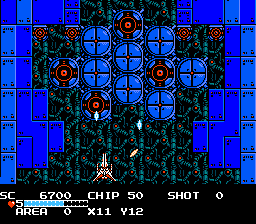 ... ...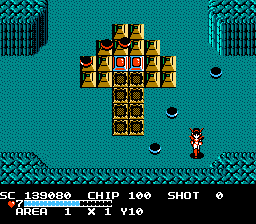
I originally bought The Guardian Legend years ago when K-Mart began selling used NES games. I took it home and played it for about 20 minutes. I passed the initial shooter stage and quickly became lost while wandering around the adventure/maze area. And that was the last I ever played of it, until just about a week ago when I picked it up again at my boyfriend’s house and proceeded to beat the entire game. Then, a few days later, I proceeded to beat the harder second quest as well. The Guardian Legend is a unique game in which you play as a female character that can transform into a spaceship as she battles to save earth from the evil forces of the planet Naju. The basic gameplay can sort of be described as Zelda meets Blaster Master meets Zanac.
GRAPHICS:
8.5/10The world of the Guardian Legend is composed of both vertically scrolling shooter stages and overhead-view adventure areas. These are further divided into different sections, and each is based on a specific environmental theme, such as water, forest, crystal, desert, and biological. The backgrounds in these areas are soaked in one basic color pattern to match the theme. (The water area is blue, forest is green, desert is brown, crystal is white, and biological is red.) The enemies, although sometimes simplistic, complement each area. Be prepared for attacks by hungry piranha, darting starfish, swooping manta rays, and territorial sea anemones that shower the screen with bullets in the water areas. The foliage of the forest area is full of oddities such as pollen-pulping tulips, flying mushrooms, and giant exploding berries. The desert is home to dinosaur bones and skulls, while creepy eyeballs watch your every move in the biological zone. Although each area looks excellent, my particular favorite is the forest, with its chartreuse background plants, and the thornbushes that look almost prerendered. The bosses are large, colorful, and impressive as well. There are giant fish, spaceship, and dragon bosses, and then weirder things such as Grimgrin – a boss who has many eyeballs and a giant gaping smile. The more you shoot him, the more his eyeballs disappear from their sockets. Aside from the backgrounds and bosses, the one other graphic effect worth mentioning is the animation of the main character transforming from a humanoid form to a spaceship and vice versa, which is very slick, even if it makes me wonder, “How exactly does she do that?”
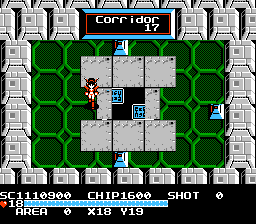 ... ...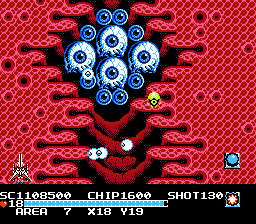
SOUND:
8/10The music in Guardian Legend is a perfect blend of atmospheric and catchy. Most of the themes are melodious with a little touch of jazz. The music for each area is different and never becomes repetitious. I liked that there were several different boss themes used. It may have taken some time for this game’s music to grow on me, but even now I can recall almost every song in the game, and I can’t think of one that I don’t really like. The sound effects are all exactly the same as those used in Compile’s earlier NES shooter, Zanac.
CONTROL:
9.5/10In all honesty, I think Guardian Legend’s control is just about perfect. In the adventure mode, you have complete freedom of movement left, right, up, down, and even diagonally. In the shooter stages, the ship moves at a very comfortable speed. It’s very easy to shoot and switch weapons in either mode. The only minor nitpick (and it’s a very minor nitpick) that I have is that I sometimes wish there was some way to turn off your special weapon without having to go to the inventory screen, but I guess that probably wasn’t possible with the limited number of buttons on an NES controller.
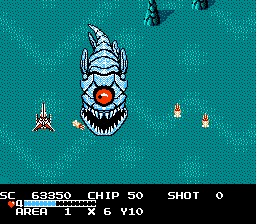 ... ...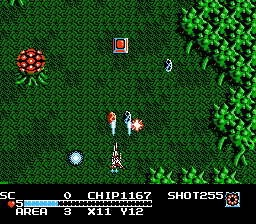
STORY/ATMOSPHERE:
7/10The Guardian Legend begins with the Guardian cyborg rocketing towards the Planet Naju. Upon defeating the boss at the gate and arriving in the planet’s mazelike interior, the Guardian receives a message on a huge computer screen that was left by Naju’s last citizen. The message tells you that Naju was once peaceful, but it has been invaded by evil alien monsters and is now on a one-way collision course with Earth. As the Guardian, it is your job to destroy these alien threats, and stop Naju, itself. From there on out you will gain clues and assistance from other computer messages and friendly Blue and Red Lander aliens. As mentioned in the graphics category, this game does an excellent job with the atmosphere by having the enemies pertain to their surroundings. And some of the scripting is very well done, such as your Guardian’s daring assault on and escape from Naju.
CHALLENGE:
6.5/10To understand a game’s challenge is to understand the game’s general philosophy. And the general philosophy of The Guardian Legend is “Power up until you’re strong enough to survive an onslaught of enemies that cannot be dodged, and pray that they drop enough power-ups to restore your health meter.” After picking up Guardian Legend and putting some serious effort into it, I had completed it several hours later. That’s not to say it was an entirely easy ride – I did have to continue quite a few times. The adventure mode is pretty much a walk in the park, and although it does have some mini-bosses and minor puzzle solving, I never really had much trouble getting through any one area. The purpose of those segments is to locate power-ups, which you’ll need to survive the more intense shooting stages. Some parts of the shooter stages become so crazy with multiple enemies filling up the screen with both themselves and their shots that it is probably impossible to dodge all of it. However, you’re not expected to. What you have to do is experiment with your special weapons and figure out which ones work best in each situation. You also have to be careful because your weapons use up both weapon and chip power, which can only be restored if the enemies drop chip capsules. If a special weapon runs out of weapon power you can not use it anymore. But if you run out of chip power you cannot use ANY special weapon anymore, and the power level of your ship’s main laser will go down. The bosses are a mixed lot – some are ludicrously easy, such as a dragon and spaceship that fire a volley of missiles which can be easily destroyed for many life-restoring power-ups. But other bosses are more difficult. One example is a giant eyeball boss who fills the screen with weird laser lines that can knock almost all of your hit points out with one touch. (You cannot even refill your energy during this battle.) Another is the aforementioned Grimgrin boss, who begins lobbing more and more projectiles at you as you fight him, until he eventually erupts into an insane volcano of eyeballs and bullets. The final boss took me several tries to beat, but upon hitting on a decent strategy, I felt more like I had to outlast him than outmaneuver him. Once you beat the game you are given a code to play a special, somewhat harder version of Guardian Legend, in which you skip the adventure portion and only play the shooter stages. (Yes, that may be a spoiler, but I’m pretty sure most people know about it, anyway.) It took me roughly the same amount of time to conquer this mode as it did the normal game. This should give you an idea how much more difficult it is, considering you don't go through the adventure areas and it took me the same length of time to beat it.
FUN:
7.5/10As mentioned before, Guardian Legend’s gameplay is divided into both an adventure mode and shooting stages, which sets it apart from almost any other game I’ve played. The adventure mode uses a grid-based system (a la Legend of Zelda) in which you walk around freely as the Guardian’s human form. Although these segments are very easy, I liked exploring them, and I’m glad the areas weren’t overly large and confusing. The game does include an in-game map, but I decided to make my own hand-drawn map which, believe it or not, is something I sorely miss doing. Some areas of the adventure mode are locked with different keys, and this is where the shooter stages come in – by completing them you will earn the keys to gain access to those areas. Sometimes, the gates to the shooter levels (or corridors as they’re called in the game) will be locked, and you’ll need to do something special to open them, in which case, you may need to search for a clue. The game’s action definitely picks up in the shooter levels, and I must confess, this is my favorite part of the game. Even when replaying the game, I kind of prefer using the code for the second quest so that I can just play the shooter levels. The better boss fights are also among my favorite parts of Guardian Legend, as they easily kept me on the edge of my seat. Defeating these bosses will sometimes net you special weapons or power-up those weapons. These are fun to experiment with and use. There’s nothing more satisfying than sending out a huge fireball that fries countless enemies in its undaunted path, or blowing up everything on-screen at once with an enemy eraser. Guardian Legend is designed for you to find which weapon gives you the biggest bang for your buck, rather than expect you to dodge everything. The game does have some amount of flicker when there’s a lot on-screen, which can be a little distracting (in my case, headache-inducing because I’m overly sensitive to certain kinds of flashing lights), but there is very little noticeable slowdown, even when moving at extremely high speeds.
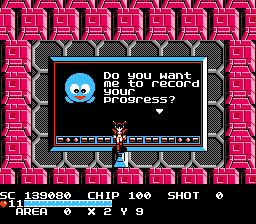 ... ...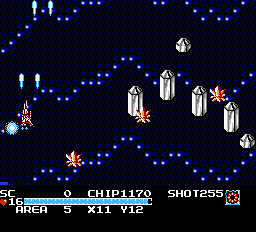
When I first beat the main adventure mode of The Guardian Legend, I came away from it with basically the same impression that I had of Section-Z – This was a good game to play for the experience, but it didn’t really blow me away. But upon completing the second quest, and after replaying it several times, I realized that Guardian Legend does have some qualities that make it superior. The adventure mode is fun to replay, and it's nice that the programmers went the extra mile by giving you the all-shooter mode, too. This gives the game decent replay value, and is enough to etch it more solidly in my mind as a game that deserves recognition.
OVERALL
SCORE (not an average): 7/10
BACK TO NES
REVIEWS BACK TO MAIN
PAGE |
|



